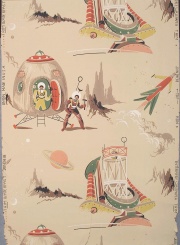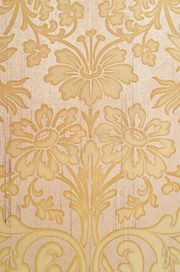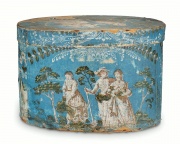Difference between revisions of "Wallpaper"
| (6 intermediate revisions by the same user not shown) | |||
| Line 1: | Line 1: | ||
[[File:Wallpaper 2002 197.jpg|thumb|Space-Age wallpaper<br>MFA# 2002.197]] | [[File:Wallpaper 2002 197.jpg|thumb|Space-Age wallpaper<br>MFA# 2002.197]] | ||
== Description == | == Description == | ||
| − | [[File:1977.955-SC138022.jpg| | + | [[File:1977.955-SC138022.jpg|thumb|Wallpaper from Roswell Gleason house<br>MFA# 1977.955]] |
| − | A decorative paper used to cover interior walls and ceilings. Wallpaper was used as early as 200 BCE in China and by the 15th century in Europe. Prior to 1835, wallpaper was typically made by painting, block printing, or stenciling designs with distemper colors onto single sheets of handmade paper. [[gum arabic|Gum Arabic]] or [[glue]] media were used with colors such as [[rose lake]], [[vermilion]], [[Prussian blue]], [[verditer]], [[indigo]], [[yellow ocher]], [[Persian berries]], [[logwood]], [[ivory black]], and [[lead white]]. In the 1830s, long rolls of machine-made wallpaper were introduced using calico printing machines. Faster drying inks were used for the colored designs. The paper was filled with clay and sized with resin or glue. The previously mentioned colors were still used with the addition of new colors such as [[chrome yellow]], [[Scheele's green]], and [[ultramarine blue, synthetic|synthetic ultramarine blue]]. Polished finishes were added to some papers using [[talc]], [[wax soap]], or [[varnish| | + | A decorative paper used to cover interior walls and ceilings. Wallpaper was used as early as 200 BCE in China and by the 15th century in Europe. Prior to 1835, wallpaper was typically made by painting, block printing, or stenciling designs with distemper colors onto single sheets of handmade paper. [[gum arabic|Gum Arabic]] or [[glue]] media were used with colors such as [[rose lake]], [[vermilion]], [[Prussian blue]], [[verditer]], [[indigo]], [[yellow ocher]], [[Persian berries]], [[logwood]], [[ivory black]], and [[lead white]]. In the 1830s, long rolls of machine-made wallpaper were introduced using calico printing machines. Faster drying inks were used for the colored designs. The paper was filled with clay and sized with resin or glue. The previously mentioned colors were still used with the addition of new colors such as [[chrome yellow]], [[Scheele's green]], and [[ultramarine blue, synthetic|synthetic ultramarine blue]]. Polished finishes were added to some papers using [[talc]], [[wax soap]], or [[varnish|Varnishes]]. |
| − | |||
| − | |||
| + | See also [[wallpaper paste]] and [[flock wallpaper]]. | ||
| + | [[File:1978.309a-b-SC58758.jpg|thumb|Band box<br>MFA# 1978.309a-b]] | ||
== Synonyms and Related Terms == | == Synonyms and Related Terms == | ||
| Line 19: | Line 19: | ||
° [http://www.conservation-wiki.com/wiki/Oddy_Test_Results:_Case_Construction_Materials#Wallpaper0003 NiP Wallpaper] tested in 2011 | ° [http://www.conservation-wiki.com/wiki/Oddy_Test_Results:_Case_Construction_Materials#Wallpaper0003 NiP Wallpaper] tested in 2011 | ||
| − | |||
| − | |||
| − | |||
| − | |||
| − | |||
| − | |||
==Resources and Citations== | ==Resources and Citations== | ||
* C.Lynn. "Colors and other Materials of Historic Wallpaper" p.58-65 in Wallpaper Conservation: A Special Issue. JAIC, 20(2): 50-151, 1981. | * C.Lynn. "Colors and other Materials of Historic Wallpaper" p.58-65 in Wallpaper Conservation: A Special Issue. JAIC, 20(2): 50-151, 1981. | ||
| − | |||
* Philippa Mapes, "Historic Wallpaper Conservation" Building Conservation Directory 1997: [http://www.buildingconservation.com/articles/wallpap/wallpap.htm Link] | * Philippa Mapes, "Historic Wallpaper Conservation" Building Conservation Directory 1997: [http://www.buildingconservation.com/articles/wallpap/wallpap.htm Link] | ||
| − | |||
* ''The Dictionary of Paper'', American Paper Institute, New York, Fourth Edition, 1980 | * ''The Dictionary of Paper'', American Paper Institute, New York, Fourth Edition, 1980 | ||
| − | |||
* E.J.LaBarre, ''Dictionary and Encyclopedia of Paper and Paper-making'', Swets & Zeitlinger, Amsterdam, 1969 | * E.J.LaBarre, ''Dictionary and Encyclopedia of Paper and Paper-making'', Swets & Zeitlinger, Amsterdam, 1969 | ||
| − | |||
* ArtLex Art Dictionary at http://www.artlex.com/ | * ArtLex Art Dictionary at http://www.artlex.com/ | ||
| − | + | * Wikipedia: [https://en.wikipedia.org/wiki/Wallpaper Wallpaper] (Accessed Nov. 29, 2005 and June 2023) - traced back to 200 BC .. Chinese | |
| − | * Wikipedia: | ||
| − | |||
* Edward Reich, Carlton J. Siegler, ''Consumer Goods: How to Know and Use Them'', American Book Company, New York City, 1937 | * Edward Reich, Carlton J. Siegler, ''Consumer Goods: How to Know and Use Them'', American Book Company, New York City, 1937 | ||
| − | |||
* ''Dictionary of Building Preservation'', Ward Bucher, ed., John Wiley & Sons, Inc., New York City, 1996 | * ''Dictionary of Building Preservation'', Ward Bucher, ed., John Wiley & Sons, Inc., New York City, 1996 | ||
| − | |||
* Book and Paper Group, ''Paper Conservation Catalog'', AIC, 1984, 1989 | * Book and Paper Group, ''Paper Conservation Catalog'', AIC, 1984, 1989 | ||
Latest revision as of 09:58, 13 May 2023
Description
A decorative paper used to cover interior walls and ceilings. Wallpaper was used as early as 200 BCE in China and by the 15th century in Europe. Prior to 1835, wallpaper was typically made by painting, block printing, or stenciling designs with distemper colors onto single sheets of handmade paper. Gum Arabic or Glue media were used with colors such as Rose lake, Vermilion, Prussian blue, Verditer, Indigo, Yellow ocher, Persian berries, Logwood, Ivory black, and Lead white. In the 1830s, long rolls of machine-made wallpaper were introduced using calico printing machines. Faster drying inks were used for the colored designs. The paper was filled with clay and sized with resin or glue. The previously mentioned colors were still used with the addition of new colors such as Chrome yellow, Scheele's green, and synthetic ultramarine blue. Polished finishes were added to some papers using Talc, Wax soap, or Varnishes.
See also Wallpaper paste and Flock wallpaper.
Synonyms and Related Terms
wall paper; Tapete (Deut.); behang (Ned.); tapet (Sven.)
Collection Risks
Links to Oddy Test results posted on AIC Wiki Materials Database Pages for individual materials below
° NiP Wallpaper tested in 2011
° NiP Wallpaper tested in 2011
° NiP Wallpaper tested in 2011
Resources and Citations
- C.Lynn. "Colors and other Materials of Historic Wallpaper" p.58-65 in Wallpaper Conservation: A Special Issue. JAIC, 20(2): 50-151, 1981.
- Philippa Mapes, "Historic Wallpaper Conservation" Building Conservation Directory 1997: Link
- The Dictionary of Paper, American Paper Institute, New York, Fourth Edition, 1980
- E.J.LaBarre, Dictionary and Encyclopedia of Paper and Paper-making, Swets & Zeitlinger, Amsterdam, 1969
- ArtLex Art Dictionary at http://www.artlex.com/
- Wikipedia: Wallpaper (Accessed Nov. 29, 2005 and June 2023) - traced back to 200 BC .. Chinese
- Edward Reich, Carlton J. Siegler, Consumer Goods: How to Know and Use Them, American Book Company, New York City, 1937
- Dictionary of Building Preservation, Ward Bucher, ed., John Wiley & Sons, Inc., New York City, 1996
- Book and Paper Group, Paper Conservation Catalog, AIC, 1984, 1989


